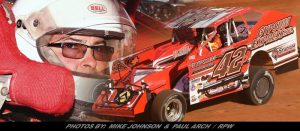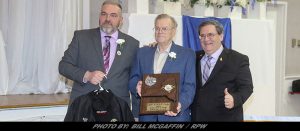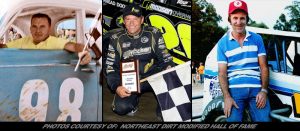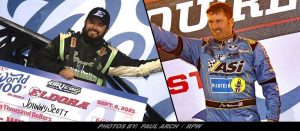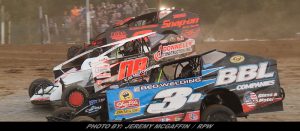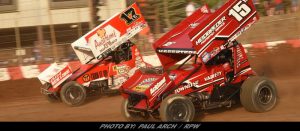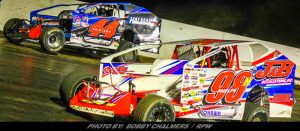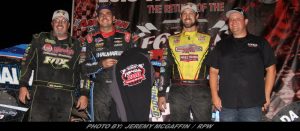Tico Conley Takes 2020 Northeast Dirt Modified Hall Of Fame Honors As A Car Owner
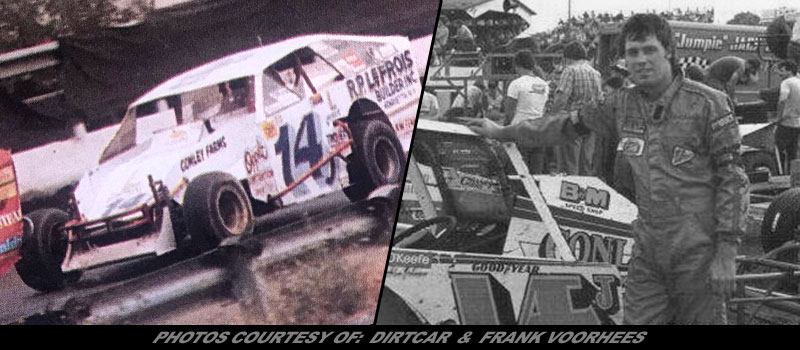
Story By: BUFFY SWANSON / NORTHEAST DIRT MODIFIED HALL OF FAME – WEEDSPORT, NY – Tico Conley, a second-generation car owner who will be forever linked to Hall of Fame driver Alan Johnson’s legacy, will be honored with the 2020 Gene DeWitt Car Owner Award when the 29th annual Northeast Dirt Modified Hall of Fame induction ceremonies are held on July 23 at the Hall of Fame and Museum on the grounds of Weedsport Speedway in New York.
Conley remembers flat-towing with his dad to Maple Grove Speedway in Waterloo, about seven miles from their home in Oaks Corners, NY. It was the end of the 1950s and Conley the Elder was fielding a flathead-powered ’37 Ford driven by Don Narrigan, racing against Cliff Kotary, Gordy Wood, Bobby Cain and other stock car stars of the day.
By the time he was 10, Tico had mastered the mindset of a car owner. Each week at Waterloo, right before the feature event, kids would race home-built push cars down the front straightaway, with a case of Coca-Cola awarded to the winner.
Conley’s little car was painted just like his dad’s: fluorescent red, number 16. And he was cunning enough — even back then — to calculate an advantage.
“The trick was to put the littlest and lightest kid you could find in the car,” Tico explained, “but I’d be standing back holding the ropes and steering it.”
Years later, Conley did take his own turn behind the wheel, driving an old Show Car — tube frame, sedan body — at Five Mile Point in 1978.
“I wasn’t very good,” Tico admitted. “I qualified for some of the features, but that’s about it.”
What he found out about himself was this: “I liked working on the cars, and being around ’em. But I didn’t like driving ‘em,” Conley conceded.
Still, he sold that first Show Car and bought another one from Scott Stacks — the Conkey-built one-off that had been featured on the cover of Stock Car Racing magazine.
In the summer of ’79, Tico took it to Canandaigua for a double-header, where a dramatic legal battle unfolded. Young up-and-comer Alan Johnson had just split with car owner Cliff Barcomb, who sent local sheriffs to the track to confiscate the Weld car Johnson was driving that night. Conley recalls the car leaving on a rollback, escorted by law enforcement and Barcomb.
“Alan came over and asked if he could drive my car, to keep his points up,” said Conley, who had failed to qualify for the event. “I told him it only had a stock 427 motor with steel heads — not what he was used to.”
But Alan was out of options — and, in his hands, the car showed promise. “It was quick,” A.J. remembered. Although they wrecked in the first race, they got it together for the nightcap. “I came from the back, passing on the outside, and wound up finishing fourth.”
At season’s end, the two got together and worked out a deal for Alan to run Tico’s car with Alan’s dad, Milt Johnson of B&M Speed, supplying the smoke.
Always willing to experiment, Johnson ingeniously reconfigured Tico’s car over the winter — and proceeded to revolutionize the sport, in the process.
“The way it was, the driver sat off to the left and the motor was offset to the right. We cut the roll cage right off it, cut the rear suspension out of it, put the motor in the middle and the seat over the driveshaft. We offset the car at least six inches,” Alan informed. “The offset wasn’t so much in my mind as widening it. And we didn’t have any money, so we left the left-rear alone and bought a right-rear tube and right-rear axle. We couldn’t afford ’em both so we just widened the right side.”
Blasting out of the box, Johnson and Conley won 20 events and the Canandaigua championship in 1980.
NASCAR star turned fabricator Maynard Troyer took notice. He was looking to branch out his chassis business to include dirt Modifieds, and Alan and Tico’s car was decidedly different and intriguing. They brought the car to Troyer over the winter. The result? Maynard’s first Mud Buss.
“Troyer built the frame and the body,” Conley said of the prototype. “But it was Alan’s suspension geometry.”
Tico remembers leaving Troyer’s shop in May of 1981 and heading straight to Canandaigua. Right off the trailer, the engine ran warm; Maynard had installed a low-profile asphalt radiator that had to be changed at the track. They had no spare parts. But Alan won anyway. Decisively.
The next afternoon, there was a big event — the DIRT Challenge Cup — at Rolling Wheels. Involved in a heat-race mishap, Alan was forced to start in the rear of the feature with brakes on only three wheels. He came up through, smoothly overtaking leader Davey Moore, in Cliff Barcomb’s car, for his second win in two tries.
Bam. They were on the map.
In the next three years, the team took down 88 victories, two Mr. DIRT and a pair of Super DIRT Series titles, the ’83 Florida tour, track championships at Weedsport, Canandaigua, Rolling Wheels and Ransomville, the 1983 Super DIRT Week classic on the Syracuse mile, and over half a million dollars in winnings and prizes.
They were out on the road, along with Hall of Fame mechanic Mike Hillman, “who was staying at my Mom and Dad’s and working on the car full time in ’83, which helped a lot,” said Tico, who had to take care of business at the family farm.
Then, in 1984, Johnson abruptly left for the promise of a “more serious” opportunity. Confounded, Conley stubbornly sat on the sidelines, refusing to put anyone else in the car.
They reunited in 1987, when Rich LeFrois, who employed Conley’s cousin at his construction company, wanted to get into the game. And Rich wanted Alan to drive.
That second time around was successful, by anyone’s standards — resulting in 61 wins, another Canandaigua Modified title and a second Super DIRT Week victory at Syracuse — but the original magic was gone.
“If Alan and I could’ve run it like we did at the start, we would’ve done a lot better,” Conley said of that 1987-93 teaming. “We didn’t run bad, but it just wasn’t there. And everyone else was catching up, too. By then, everyone was running the same cars.”
By 1994, LeFrois had lost interest. And Conley called it quits. After 169 feature wins with Alan in the seat, at 24 different tracks in five states and two Canadian provinces, Tico was done.
Yet it’s all come full circle: For the past five years, Alan has driven for Mark Spoor, who is Tico’s nephew. Conley Farms is lettered on the car, and Tico still comes around to occasionally lend a hand at the shop or chip in for a set of tires.
As for Hall of Fame honors as a car owner, Conley knows where he stands.
“If it wasn’t for Alan, I wouldn’t even be in the conversation,” he candidly concluded.


